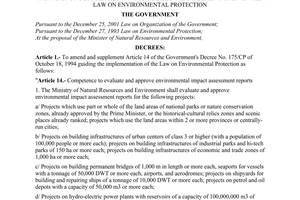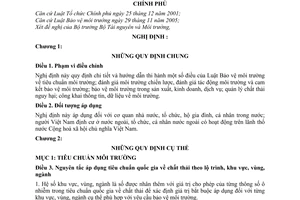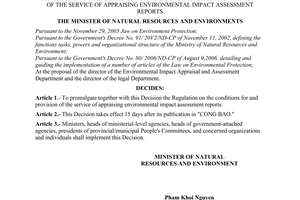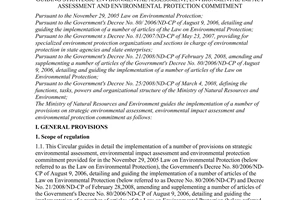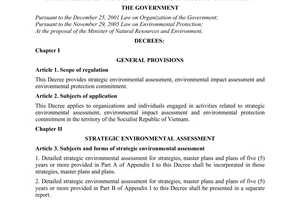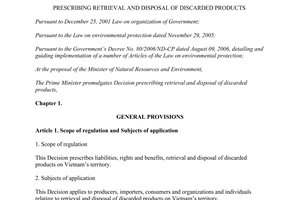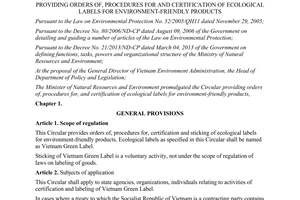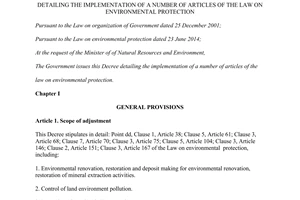Decree of Government No. 80/2006/ND-CP, detailing and guiding the implementation of a number of articles of the Law on Environmental Protection đã được thay thế bởi Decree No. 19/2015/ND-CP detailing the Law on Environmental Protection và được áp dụng kể từ ngày 01/04/2015.
Nội dung toàn văn Decree of Government No. 80/2006/ND-CP, detailing and guiding the implementation of a number of articles of the Law on Environmental Protection
|
THE
GOVERNMENT |
OF VIET |
|
No. 80/2006/ND-CP |
, August 09, 2006 |
DECREE
DETAILING AND GUIDING THE IMPLEMENTATION OF A NUMBER OF ARTICLES OF THE LAW ON ENVIRONMENTAL PROTECTION
THE GOVERNMENT
Pursuant to the December 25,
2001 Law on Organization of the Government;
Pursuant to the November 29, 2005 Law on Environmental Protection;
At the proposal of the Minister of Natural Resources and Environment,
DECREES:
Chapter I
GENERAL PROVISIONS
Article 1.- Scope of regulation
This Decree details and guides the implementation of a number of articles of the Law on Environmental Protection regarding environmental standards; strategic environmental assessment; environmental impact assessment and environmental protection commitments; environmental protection in production, business and services; hazardous waste management; and disclosure of environmental information and data.
Article 2.- Subjects of application
This Decree applies to state agencies, domestic organizations, households and individuals; overseas Vietnamese, foreign organizations and individuals engaged in activities in the territory of the Socialist Republic of Vietnam.
Chapter II
SPECIFIC PROVISIONS
Section 1. ENVIRONMENTAL STANDARDS
Article 3.- Principles of application of national waste standards according to roadmap, by region, geographical area and branch
1. Region-, geographical area- or branch-based coefficient means a figure by which the permitted value of each pollution parameter in the national waste standards shall be multiplied in order to determine the value to be compulsorily applied to each particular region, geographical area or branch to suit environmental protection requirements.
2. Roadmap for application of national waste standards shall be set in the direction of greater strictness to meet environmental protection requirements in each period and specified in decisions announcing the compulsory application of such standards.
3. Waste standard coefficients shall be determined on the following principles:
a/ Region- and geographical area-based coefficients of waste standards shall be stricter for areas zoned off for nature conservation, areas with sensitive eco-system, urban centers, residential areas and polluted areas;
b/ Branch-based coefficients of waste standards shall be determined based on the environmental characteristics of each particular production branch.
Article 4.- Responsibility to formulate and competence to promulgate and announce national environmental standards for compulsory application
1. The formulation of national environmental standards shall be organized according to the following provisions:
a/ The Ministry of Natural Resources and Environment shall guide formulation methods, assume the prime responsibility for, and coordinate with concerned ministries and branches in, identifying national environmental standards which need to be promulgated and assigning the tasks of formulating national environmental standards;
b/ Ministries, ministerial-level agencies and government-attached agencies shall organize the formulation of national environmental standards within the branches and domains under their respective management or assigned to them, then send them to the Ministry of Natural Resources and Environment for evaluation and promulgation.
2. The Ministry of Natural Resources and Environment shall promulgate and announce national environmental standards for compulsory application to each particular region, geographical area or branch.
Article 5.- Order and procedures for formulation, evaluation, promulgation and declaration of national environmental standards for compulsory application
1. The formulation of national environmental standards shall involve the following steps:
a/ Referring to relevant international standards and standards applied by countries with conditions comparable with ’s;
b/ Assessing basic requirements on national environmental standards and forecasting impacts of the compulsory application thereof;
c/ Identifying the scope of regulation, subjects of application, parameters of national environmental standards and limit value of each parameter enclosed with standard methods of measurement, sampling and analysis used for determining such parameters;
d/ Organizing the compilation of environmental standards;
e/ Organizing the collection of opinions of interested parties on and finalizing draft national environmental standards;
f/ Requesting the Ministry of Natural Resources and Environment to expertise draft national environmental standards before promulgating them.
2. A dossier of request for expertise of a draft national environmental standard consists of:
a/ An official letter requesting expertise of the environmental standard;
b/ A rationale document on the necessity, objective and process of formulation, divergent opinions and the opinion of the environmental standard-formulating agency;
c/ The draft environmental standard.
3. Expertise and promulgation of national environmental standards shall be as follows:
a/ After receiving the valid dossier of request for expertise, the Ministry of Natural Resources and Environment shall set up a technical board for national environmental standard, comprising experts who have professional competence and experience relevant to the standard concerned and authorized representatives of concerned ministries, ministerial-level agencies and/or government-attached agencies;
b/ Within no more than 30 (thirty) working days after receiving the complete and valid dossier of request for expertise, the technical board for national environmental standard shall have to expertise the draft national environmental standard and submit the expertise result to the Ministry of Natural Resources and Environment.
Within 15 (fifteen) working days after receiving the expertise result report, the Ministry of Natural Resources and Environment shall decide to promulgate the national environmental standard; if disagreeing with the expertise result or refusing to promulgate the national environmental standard, it shall request the technical board for national environmental standard to re-expertise the draft standard or request the standard-formulating agency to further improve the draft environmental standard.
4. Announcement of national environmental standards for compulsory application shall be as follows:
a/ Depending on each national environmental standard, the Ministry of Natural Resources and Environment shall set a roadmap for application thereof and coefficients for each particular region, geographical area or branch on the basis of the principles laid down in Article 3 of this Decree and announce the compulsory application thereof;
b/ Organizations and individuals shall have to comply with national environmental standards from the effective date of the decisions announcing the compulsory application thereof.
5. The technical board for national environmental standard, in the capacity as a technical advisory body, shall be set up upon request and operate to assist the Ministry of Natural Resources and Environment in expertising draft national environmental standards and shall dissolve after finishing its duties.
The Ministry of Natural Resources and Environment shall stipulate in detail the operation of the technical board for national environmental standard.
Section 2. STRATEGIC ENVIRONMENTAL ASSESSMENT, ENVIRONMENTAL IMPACT ASSESSMENT AND ENVIRONMENTAL PROTECTION COMMITMENTS
Article 6.- List of projects subject to making of environmental impact assessment report and guidance on the financial regime applicable to activities of making, appraising and monitoring environmental impact assessment reports
1. Projects subject to making of environmental impact assessment report are listed in Appendix I to this Decree.
2. The Ministry of Finance shall assume the prime responsibility for, and coordinate with the Ministry of Natural Resources and Environment in, providing guidance on the financial regime applicable to activities of making, appraising, and monitoring the implementation of, strategic environmental assessment reports, environmental impact assessment reports and written environmental protection commitments.
Article 7.- Inter-branch and inter-provincial projects with environmental impact assessment reports to be appraised and approved by the Ministry of Natural Resources and Environment
Inter-branch and inter-provincial projects with environmental impact assessment reports to be appraised and approved by the Ministry of Natural Resources and Environment are listed in Appendix II to this Decree.
Article 8.- Conditions and scope of operation of organizations providing the consultancy service on making environmental impact assessment reports
1. Organizations providing the consultancy service on making environmental impact assessment reports shall have to meet all the following conditions:
a/ Having technical, technological and environmental personnel with expertise appropriate to the project’s domain;
b/ Having facilities, machinery and equipment up to standard and quality according to regulations on measurement and taking of environmental samples and other related samples suitable to the characteristics and execution sites of projects;
c/ Having material and technical foundations and laboratories ensuring the processing and analysis of environmental samples and other samples related to projects. In case of having no qualified laboratories, consultancy service-providing organizations must hire on a contractual basis other laboratories that are qualified.
2. All domestic and foreign organizations that have registered to operate in and meet all conditions specified in Clause 1 of this Article shall be allowed to provide the consultancy service on making environmental impact assessment reports, except those of projects in the security and defense domain and projects involving state secrets.
3. Agencies and units shall have to check the conditions specified in Clause 1 of this Article before hiring organizations to provide the consultancy service on making environmental impact assessment reports.
Article 9.- Dossiers of request for appraisal of strategic environmental assessment reports, environmental impact assessment reports and dossiers of registration of written environmental protection commitments
1. A dossier of request for appraisal of a strategic environmental assessment report shall comprise:
a/ The project owner’s written request for appraisal;
b/ The strategic environmental assessment report;
c/ The draft document on the strategy, planning or plan.
2. A dossier of request for appraisal of an environmental impact assessment report shall comprise:
a/ The project owner’s written request for appraisal;
b/ The environmental impact assessment report;
c/ The project’s feasibility study or investment report.
3. A dossier of registration of written environmental protection commitments shall comprise:
a/ Written environmental protection commitments;
c/ The project’s feasibility study or investment explanation report.
4. Dossiers of request for appraisal of strategic environmental assessment reports, dossiers of request for appraisal of environmental impact assessment reports and dossiers of registration of written environmental protection commitments shall be addressed to competent agencies specified in Articles 17, 21 and 26 of the Law on Environmental Protection.
5. The Ministry of Natural Resources and Environment shall provide guidance on dossier forms and number of dossier sets for dossiers of request for appraisal of strategic environmental assessment reports, dossiers of request for appraisal of environmental impact assessment reports and dossiers of registration of written environmental protection commitments.
6. If receiving improper dossiers, dossier-receiving agencies shall, within five working days, have to notify the project owners thereof for addition and completion.
Article 10.- Appraisal of strategic environmental assessment reports
1. Heads of agencies specified in Clause 7, Article 17 of the Law on Environmental Protection shall issue decisions to set up appraisal councils for strategic environmental assessment reports of projects.
2. Results of appraisal of strategic environmental assessment reports shall be expressed in the form of minutes of meetings of the appraisal council, which shall fully contain the meeting proceedings, conclusions and signatures of the council’s chairman and secretary.
3. The Minister of Natural Resources and Environment shall report to the Prime Minister, the Government and the National Assembly on results of appraisal of strategic environmental assessment reports of projects, enclosed with the appraisal council’s minutes serving as the basis for project approval.
4. Specialized environmental protection agencies of ministries, ministerial-level agencies, government-attached agencies and provincial/municipal People’s Committees shall report to the ministers or agency heads who are competent to approve projects on results of appraisal of strategic environmental assessment reports of projects, enclosed with the appraisal council’s minutes serving as the basis for project approval.
5. Appraisal councils for strategic environmental assessment reports shall operate according to regulations issued by the Minister of Natural Resources and Environment.
Article 11.- Appraisal of environmental impact assessment reports
1. Heads of agencies specified in Clause 7, Article 21 of the Law on Environmental Protection shall issue decisions to set up appraisal councils for environmental impact assessment reports of projects.
2. Heads of agencies specified in Clause 7, Article 21 of the Law on Environmental Protection shall base themselves on the technical, technological and environment complexity of projects to decide on the form of appraisal either by an appraisal council or appraisal service organization. For projects in the security and defense domain and projects involving national secrets, only service organizations within the security or defense branch shall be selected.
3. Appraisal councils or appraisal service organizations shall have the function of giving advice to assist competent agencies in examining and assessing the quality of environmental impact assessment reports serving as the basis for consideration and approval according to regulations.
4. In case of necessity, before the opening of official meetings of appraisal councils, agencies responsible for conducting the appraisal may conduct auxiliary appraisal in the following forms:
a/ Survey of the project’s execution site and adjacent areas;
b/ Taking samples for analysis and verification;
c/ Gathering opinions of the population community in the place where the project is to be executed;
d/ Collecting comments of related experts outside the appraisal council, related scientific and technological institutions, socio and professional organizations, and non-governmental organizations;
e/ Holding appraisal seminars.
5. Appraisal councils and appraisal service organizations appraising environmental impact assessment reports shall operate according to regulations issued by the Minister of Natural Resources and Environment.
Article 12.- Time limit for appraisal of strategic environmental assessment reports and environmental impact assessment reports
1. For projects falling under the deciding and approving competence of the Prime Minister, the Government or the National Assembly, and inter-branch and inter-province projects, the time limit for appraisal shall be 45 (forty five) working days counting from the date of receipt of complete and valid dossiers.
2. For projects other than those mentioned in Clause 1 of this Article, the time limit for appraisal shall be 30 (thirty) working days counting from the date of receipt of complete and valid dossiers.
3. In case a strategic environmental assessment report or environmental impact assessment report is not approved and therefore needs to be re-appraised, the time limit for re-appraisal shall be as provided for in Clause 1 and Clause 2 of this Article.
Article 13.- Making of additional environmental impact assessment reports
1. Additional environmental impact assessment reports shall be made in the following cases:
a/ There is a change in the project’s location, size, design capacity or technology;
b/ The project fails to be executed within 24 months following the date of approval of its environmental impact assessment report.
2. An additional environmental impact assessment report shall cover the following particulars:
a/ Changes in the project’s content;
b/ Changes in the natural environmental conditions and economic and social factors up to the time the additional environmental impact assessment report is made;
c/ Changes in environmental impacts and measures to minimize negative impacts;
d/ Changes in the project’s environmental management and monitoring program;
e/ Other changes.
3. Within 30 (thirty) working days after the date of receipt of complete and valid dossiers, state agencies competent to approve environmental impact assessment reports shall have to examine and approve additional environmental impact assessment reports.
Article 14.- Responsibilities of project owners after environmental impact assessment reports are approved
1. To send a report to the district-level People’s Committee of the place where the project shall be executed on the contents of the decision approving the environmental impact assessment report enclosed with a copy of the decision.
2. To publicly post up at the project execution site a summary of the approved environmental impact assessment report, clearly stating the categories and volume of waste; waste treatment technology and equipment; degree of treatment according to typical parameters of waste against set standards; other environmental protection measures.
3. Designing, building and installation of environmental treatment facilities:
a/ On the basis of the fundamental plan of environmental treatment facilities included in the approved environmental impact assessment report, to design, build and install these facilities according to current investment and construction regulations;
b/ After the detailed designs of projects’ environmental treatment facilities are approved, to send a report on the building and installation plan enclosed with the detailed design dossier of environmental treatment facilities to the state agency which has approved the environmental impact assessment reports for monitoring and supervision.
4. Environmental protection in the course of project execution:
a/ In the course of project execution, to take measures to protect the environment and minimize negative environmental impacts caused by the projects and carry out environmental observation according to requirements set in the approved environmental impact assessment reports as well as other requirements stated in the decisions approving the environmental impact assessment reports;
b/ During the project execution, to propose adjustments to or changes in the approved or certified contents and related environmental protection measures, to send a report thereon to the approving or certifying agency and to effect these adjustments or changes only after obtaining written approval of this agency;
c/ If environmental pollution occurs in the course of project execution and trial operation, to immediately stop the execution or trial operation and send a report thereon to the district-level Natural Resources and Environment Section of the place where the project is executed and the agency having approved the environmental impact assessment report;
d/ To cooperate with and create favorable conditions for the state management agency in charge of environmental protection to monitor and supervise the implementation of environmental protection contents and measures of the projects; to supply sufficient relevant information and data upon request.
5. Trial operation of environmental treatment facilities:
a/ After the completion and take-over of construction and installation of environmental treatment facilities, these facilities shall be operated on a trial basis to check technical and environmental parameters against their designs;
b/ To draw up a trial operation plan and notify it to the agency which has approved the environmental impact assessment reports, the provincial/municipal Natural Resources and Environment Service and the district-level Natural Resources and Environment Section as well as the population community in the place where the project is executed for preparing monitoring and supervision plans;
c/ If unable to measure and analyze by themselves technical and environmental parameters, to sign contracts with professionally and technically capable organizations to conduct such measurement and analysis;
d/ After completing the trial operation, to send a report requesting certification of the result of trial operation of environmental treatment facilities to the agency which has approved the environmental impact assessment reports for certification.
Article 15.- Responsibilities of state agencies after having approved environmental impact assessment reports
1. Ministries, ministerial-level agencies and government-attached agencies shall send their respective original decisions approving environmental impact assessment reports to the provincial-level People’s Committees of the places where projects shall be executed.
2. Provincial-level People’s Committees shall send copies of their decisions approving environmental impact assessment reports and those of ministries, ministerial-level agencies or government-attached agencies to the district-level People’s Committees of the places where the projects shall be executed.
3. After having approved environmental impact assessment reports, competent state agencies shall have the following responsibilities:
a/ To examine and compare dossiers on design, construction and installation of environmental treatment facilities against the approved environmental impact assessment reports; if detecting any inconsistencies with the environmental impact assessment reports, within 7 (seven) working days after receiving the dossiers and reports, to inform in writing the project owners concerned thereof for adjustment and/or supplementation;
b/ To receive and process proposals and recommendations of project owners, interested organizations and individuals concerning the implementation of environmental protection contents and measures in the course of execution and construction of projects;
c/ To plan and conduct monitoring and supervision of the implementation of environmental protection contents and measures; to handle violations according to their competence or propose the handling thereof;
d/ To supervise and control the project owners’ trial operation of environmental treatment facilities after receiving project owners’ trial operation plans;
e/ To examine and certify the results of trial operation of environmental treatment facilities;
f/ To preserve and manage all dossiers and documents on post-appraisal activities sent by project owners and concerned agencies and individuals.
Article 16.- Dossiers, order and procedures for examining and certifying compliance with requirements set in decisions approving environmental impact assessment reports
1. A dossier of request for examination and certification shall consist of:
a/ Written request for examination and certification;
b/ Written description of environmental protection facilities and measures stated in the environmental impact assessment report, enclosed with the design dossier and technical parameters of environmental protection facilities and equipment.
Environmental protection and treatment facilities must be technically surveyed before requests for examination and certification are filed.
c/ Relevant recognition and survey certificates.
2. Within 15 (fifteen) working days after receiving valid dossiers of project owners, agencies having issued decisions approving environmental impact assessment reports shall have to examine and certify in writing the project owners’ compliance with the contents of the approved environmental impact assessment reports. For projects involving complicated matters which need more time for examination, this time limit may be extended for no more than 10 (ten) working days. If, through examination, detecting that the project owner fails to fully and properly comply with the contents of the environmental impact assessment report, to request the project owner to do so and report its compliance to the agency having issued the decision approving the environmental impact assessment report for further examination and certification.
3. For each particular project, the contents to be examined and certified shall depend on the contents of its approved environmental impact assessment report, with the following contents to be taken into special consideration:
a/ The waste water collection and treatment system;
b/ Equipment for collecting and detaining hazardous waste and measures for treating them;
c/ Measures for managing ordinary solid waste;
d/ Measures and equipment for treating and collecting discharged gas and dust;
e/ Measures and equipment for reducing noise and vibration;
f/ Plan, measures and necessary conditions for preventing and responding to environmental incidents.
4. The forms and specific contents of reports and certification documents shall comply with the guidance of the Ministry of Natural Resources and Environment.
Article 17.- Registration of written environmental protection commitments
1. After receiving complete and valid dossiers and within the time limit specified in Clause 2, Article 26 of the Law on Environmental Protection, district-level People’s Committees or authorized commune-level People’s Committees shall have to grant certificates to entities required to register written environmental protection commitments.
2. The form and contents of certificates of registration of written environmental protection commitments shall comply with the guidance of the Ministry of Natural Resources and Environment.
Section 3. ENVIRONMENTAL PROTECTION IN PRODUCTION, BUSINESS AND SERVICE ACTIVITIES
Article 18.- Environment-friendly production and service establishments and products
1. Environment-friendly production and service establishments are those meeting the following requirements:
a/ Strictly observing the law on environmental protection and acquiring a certificate of satisfaction of environmental standards;
b/ Having policies on managing products throughout their life and managing waste according to the provisions of law, with over 70% of total quantity of waste to be re-processed and/or re-used;
c/ Successfully performing environmental management and acquiring an ISO 14001 certificate therefor;
d/ Saving over 10% of material, energy, fuel and water compared to the common consumption level;
e/ Actively participating in and contributing to programs on enhancing public awareness and protecting the public environment;
f/ The recognition of the title of environment-friendly establishment is not opposed by the population community in the production or service provision area.
2. Environment-friendly products are those meeting one of the following requirements:
a/ Being re-processed from waste which are up to environmental standard;
b/ Being easy to disintegrate in the nature after use;
c/ Being non-polluting products produced to substitute natural material;
d/ Being organic farm produce;
e/ Being granted with eco-marks by a state-accredited organization.
3. Environment-friendly production and service establishments shall enjoy priority and preferential treatment policies and supports of the State in accordance with the provisions of law.
4. The Ministry of Natural Resources and Environment shall guide the evaluation and consideration and procedures for recognition of environment-friendly production and service establishments and products.
Article 19.- Environmental protection in the import, temporary import, border gate-to-border gate transport and transit of scraps
1. If organizations and individuals importing scraps fail to comply with the provisions of Clause 1 and Clause 2, Article 43 of the Law on Environmental Protection, they shall, depending on the nature and severity of their violations, be administratively handled or examined for penal liability. If causing damage, they shall have to compensate therefor according to the provisions of law.
2. Temporary import and border gate-to-border gate transport of scraps shall have to strictly meet the following requirements:
a/ Scraps must not be unpacked, used and dispersed in the course of transportation and storage in ;
b/ Scraps must not be altered in nature and weight;
c/ Scraps must all be re-exported or transported out of ;
3. Transit of scraps through the Vietnamese territory shall have to meet similar environmental protection requirements prescribed in Article 42 of the Law on Environmental Protection for transit of goods.
Section 4. WASTE MANAGEMENT
agencies’ responsibilities for hazardous waste management
1. The Ministry of Natural Resources and Environment shall have the following responsibilities:
a/ To guide the process of minimizing, making statistics on, declaring and managing hazardous waste;
b/ To issue the list of hazardous wastes;
c/ To grant permits and codes of management of hazardous wastes to organizations engaged in waste management in two or more provinces and centrally run cities;
d/ To guide the transport of hazardous wastes to abroad for treatment under international conventions to which Vietnam is a contracting party in cases where there is no appropriate treatment technology or equipment in the country.
2. Provincial/municipal People’s Committees shall have the following responsibilities:
a/ To make statistics on and assess hazardous wastes arising in their localities and take appropriate management measures;
b/ To arrange ground areas and conditions necessary for management of hazardous wastes in the localities in line with the approved plannings on collection, treatment and burial of hazardous wastes;
c/ To grant permits and codes of management of hazardous wastes to organizations engaged in waste management in the localities, except for cases specified at Point c, Clause 1 of this Article.
Article 21.- Retrieval and disposal of used or discarded products
1. Products specified in Clause 1, Article 67 of the Law on Environmental Protection must bear codes of their hazard level and re-processing capability in order to define responsibilities and measures to retrieve and dispose of expired products or products discarded by consumers.
In case of import, importing organizations and individuals shall have to register quantities and necessary information of products with the central state management agency in charge of environmental protection in order to define responsibilities and measures to retrieve or dispose of products discarded by consumers.
2. Depending on the practical situation and environmental protection requirements in each period, the Ministry of Natural Resources and Environment shall submit to the Prime Minister regulations on retrieval and disposal of expired or used products.
Section 5. OTHER PROVISIONS
Article 22.- Appraisal and assessment of environmental technologies and management of bio-products used in environmental protection
1. Environmental technologies to be appraised and assessed include:
a/ Newly invented environmental technologies;
b/ Imported environmental technologies of unknown origin;
c/ Other environmental technologies upon request of suppliers, users or competent state management agencies.
2. Publicization, certification and transfer of appraised and assessed environmental technologies shall comply with the provisions of law on science and technology.
3. The Ministry of Science and Technology shall assume the prime responsibility for, and coordinate with the Ministry of Natural Resources and Environment in, providing specific guidance on the assessment of environmental technologies in accordance with the provisions of law on science and technology and environmental protection.
4. The Ministry of Natural Resources and Environment shall issue the list of bio-products to be used for waste prevention, minimization and treatment and the list of polluting bio-products banned from import.
Article 23.- Publicization of environmental information and data
1. The responsibility to publicize environmental information and data defined in Clause 1, Article 104 of the Law on Environmental Protection is prescribed as follows:
a/ The Ministry of Natural Resources and Environment shall have to publicize information and data on the national environment;
b/ Ministries, ministerial-level agencies and government-attached agencies shall have to publicize environmental information and data in the branches or domains under their respective management;
c/ Specialized environmental protection agencies of the People’s Committees at all levels shall to publicize environmental information and data in the localities under their respective management;
d/ The Management Boards of economic zones, industrial parks and export processing zones and owners of production and service establishments shall to publicize environmental information and data under their respective management.
2. Forms of publicization of environmental information and data are prescribed as follows:
a/ Wide dissemination in the forms of books and news reports in the press and websites of the units, for cases specified at Point a and Point b, Clause 1 of this Article;
b/ Wide dissemination in the forms of books, news reports in the press and websites of the units (if any), reports at People’s Council meetings, announcements at population quarter meetings, posting at head offices of units and People’s Committees of communes, wards and townships where units operate, for cases specified at Points c and d, Clause 1 of this Article.
Chapter III
IMPLEMENTATION PROVISIONS
Article 24.- Implementation effect
1. This Decree shall take effect 15 days after its publication in “CONG BAO.”
2. To hereby repeal the following decrees:
a/ The Government’s Decree No. 175/CP of October 18, 1994, on implementation of the 1993 Law on Environmental Protection;
b/ The Government’s Decree No. 143/2004/ND-CP of July 12, 2004, amending and supplementing Article 14 of the Government’s Decree No. 175/CP of October 18, 1994, guiding the implementation of the 1993 Law on Environmental Protection.
Article 25.- Implementation responsibilities
1. The Minister of Natural Resources and Environment shall have to guide and organize the implementation of this Decree.
2. Ministers, heads of ministerial-level agencies, heads of government-attached agencies and presidents of provincial/municipal People’s Committees shall have to implement this Decree.
|
ON
BEHALF OF THE GOVERNMENT |
APPENDIX I
LIST OF PROJECTS SUBJECT TO MAKING OF ENVIRONMENTAL
IMPACT ASSESSMENT REPORT
(Enclosed with the Government’s Decree No. 80/2006/ND-CP of August 9, 2006)
|
Ordinal number |
Projects |
Size |
|
1 |
Projects on key national works |
All |
|
2 |
Projects using part or the whole of land areas of or adversely affecting nature conservation zones, national parks, historical-cultural relic areas, natural heritages and famous scenic places, ranked or not yet ranked, which are protected under decisions of provincial/municipal People’s Committees |
All |
|
3 |
Projects involving risks of directly and badly affecting water sources in river basins, coastal areas and areas having protected eco-systems |
All |
|
4 |
Projects on nuclear power plants |
All |
|
5 |
Projects on thermonuclear power plants |
All |
|
6 |
Projects on building nuclear reactors |
All |
|
7 |
Projects on building production, business and service establishments using radioactive substances or discharging radioactive wastes |
All |
|
8 |
Projects on building telecommunications facilities |
All |
|
9 |
Projects on building infrastructures in urban centers or residential areas |
All |
|
10 |
Projects on building infrastructures in industrial parks, hi-tech parks, industrial clusters, export-processing zones or trade village clusters |
All |
|
11 |
Projects on building infrastructures in economic and commercial zones |
All |
|
12 |
Projects on building, renovating and upgrading motorways, grade-I, grade-II and grade-III roads |
All |
|
13 |
Projects on building grade-IV roads |
50 km or more in length |
|
14 |
Projects on building, upgrading and renovating railways |
100 km or more in length |
|
15 |
Projects on building permanent road and railway bridges |
200 m or more in length (excluding the length of access roads) |
|
16 |
Projects on building, upgrading and renovating traffic works |
Requiring resettlement of 2,000 or more people |
|
17 |
Projects on building and repairing ships |
Ships with a tonnage of 1,000 DWT or more |
|
18 |
Projects on plants of building, repairing and assembling locomotives and automobiles |
Design capacity of 500 vehicles or more per year |
|
19 |
Projects on constructing, renovating and upgrading riverports and seaports |
For ships with a tonnage of 1,000 DWT or more |
|
20 |
Airports and airfields |
All |
|
21 |
Projects on building subways and tunnels |
500 m or more in length |
|
22 |
Projects on building overhead railways |
2,000 m or more in length |
|
23 |
Projects on exploitation of oil and gas |
All |
|
24 |
Projects on petrochemical refineries (except projects on LPG extraction and lubricant preparation) |
All |
|
25 |
Projects on building oil and gas pipelines |
All |
|
26 |
Projects on petrol depots |
Capacity of 1,000 m3 or more |
|
27 |
Projects on production of petrochemical products (surfactants, plasticizers, methanol) |
All |
|
28 |
Projects on vessel clean-up |
All |
|
29 |
Projects on building oil and gas entrepots |
All |
|
30 |
Projects on thermopower plants |
Capacity of 50 MW or more |
|
31 |
Projects on hydropower plants |
Reservoir with a capacity of 1,000,000 m3 or more |
|
32 |
Projects on building high-voltage power lines |
50 km or more in length |
|
33 |
Projects on iron, steel and non-ferrous metals rolling and refining plants |
Design capacity of 5,000 tons or more of products per year |
|
34 |
Projects on plastics plants |
Design capacity of 1,000 tons or more of products per year |
|
35 |
Projects on chemical fertilizer plants |
Design capacity of 10,000 tons or more of products per year |
|
36 |
Projects on warehouses of chemicals and plant protection drugs |
Capacity of 10 tons or more |
|
37 |
Projects on paint and base chemical plants |
Design capacity of 1,000 tons or more of products per year |
|
38 |
Projects on detergent and additive plants |
Design capacity of 1,000 tons or more of products per year |
|
39 |
Projects on plant protection drug plants |
Design capacity of 500 tons or more of products per year |
|
40 |
Projects on rubber latex processing plants |
Design capacity of 10,000 tons or more of products per year |
|
41 |
Projects on rubber processing plants |
Design capacity of 1,000 tons or more of products per year |
|
42 |
Projects on pharmaceutical and cosmetics plants |
Design capacity of 50 tons or more of products per year |
|
43 |
Projects on plants to manufacture car and tractor tires and tubes |
Design capacity of 50,000 or more of products per year |
|
44 |
Projects on accumulator plants |
Design capacity of 50,000 kWh or more per year |
|
45 |
Projects on cement plants |
Design capacity of 500,000 tons or more of cement per year |
|
46 |
Projects on tile and brick plants |
Design capacity of 20 mil. tiles and bricks or more per year |
|
47 |
Projects on plants to produce other construction materials |
Design capacity of 10,000 tons or more of products per year |
|
48 |
Projects on exploitation of construction materials (earth, rock, sand and gravel) on the mainland |
Design capacity of 50,000 m3 or more of materials per year |
|
49 |
Projects on exploitation, dredging and full extraction of construction materials from river beds (sand and gravel) |
Design capacity of 50,000 m3 or more of materials per year |
|
50 |
Projects on exploitation of solid minerals (without using chemicals) |
Volume of 100,000 m3 or more of solid minerals, earth and rock per year |
|
51 |
Projects on exploitation and processing of solid minerals containing hazardous substances or involving the use of chemicals |
All |
|
52 |
Projects on processing of solid minerals |
Design capacity of 50,000 tons or more of products per year |
|
53 |
Projects on exploitation of groundwater |
Design capacity of 1,000 m3 or more of water per day and night |
|
54 |
Projects on exploitation of surface water |
Design capacity of 10,000 m3 or more of water per day and night |
|
55 |
Projects on food processing plants |
Design capacity of 1,000 tons or more of products per year |
|
56 |
Projects on frozen aquatic product processing plants |
Design capacity of 1,000 tons or more of products per year |
|
57 |
Projects on sugar plants |
Design capacity of 20,000 tons or more of sugarcane per year |
|
58 |
Projects on alcohol and spirit plants |
Design capacity of 100,000 liters or more per year |
|
59 |
Projects on beer and beverage plants |
Design capacity of 500,000 liters or more of products per year |
|
60 |
Projects on monosodium glutamate plants |
Design capacity of 5,000 tons or more of products per year |
|
61 |
Projects on milk processing plants |
Design capacity of 10,000 tons or more of products per year |
|
62 |
Projects on coffee processing plants |
Design capacity of 5,000 tons or more of products per year |
|
63 |
Projects on cigarette plants |
Design capacity of 50,000 packs or more per year |
|
64 |
Projects on slaughter plants/houses |
Design capacity of 100 cattle or 1,000 poultry or more per day |
|
65 |
Projects on ice plants |
Design capacity of 500 ice bars or more per day and night or 25,000 kg or more of ice water per day and night |
|
66 |
Projects on cereals processing mills |
Design capacity of 10,000 tons or more of products per year |
|
67 |
Projects on manioc processing mills |
Design capacity of 1,000 tons or more of products per year |
|
68 |
Projects on leather tanning plants |
All |
|
69 |
Projects on dyeing textile plants |
All |
|
70 |
Projects on non-dyeing textile plants |
Capacity of 10,000,000 m of fabric per year |
|
71 |
Projects on mechanical and engineering plants |
Design capacity of 1,000 tons or more of products per year |
|
72 |
Projects on timber and plywood processing plants |
Design capacity of 100,000 m2 or more per year |
|
73 |
Projects on plants to manufacture electric and electronic appliances |
Design capacity of 10,000 or more appliances per year |
|
74 |
Projects on plants to manufacture electric and electronic components |
Design capacity of 10,000 tons or more of products per year |
|
75 |
Projects on plants to produce fine art articles |
Design capacity of 1,000,000 tons or more of products per year |
|
76 |
Projects on constructing reservoirs and irrigation lakes |
Capacity of 1,000,000 m3 of water or more |
|
77 |
Projects on building irrigation and anti-salinization systems |
Covering an area of 500 ha or more |
|
78 |
Projects on sea progradation dykes |
All |
|
79 |
Projects on aquaculture zones: intensive/semi-intensive farming |
Water surface area of 10 ha or more |
|
80 |
Projects on extensive aquaculture |
Water surface area of 50 ha or more |
|
81 |
Projects on aquaculture on sand |
All |
|
82 |
Projects on cattle farms |
100 cattle heads or more |
|
83 |
Projects on poultry farms |
10,000 poultry heads or more |
|
84 |
Projects on feed processing plants |
Design capacity of 10,000 tons or more of products per year |
|
85 |
Projects on forestation and forest exploitation |
Area of 1,000 ha or more |
|
86 |
Projects on building concentrated cassava and sugarcane growing zones |
Area of 100 ha or more |
|
87 |
Projects on building coffee growing zones |
Area of 100 ha or more |
|
88 |
Projects on building tea growing zones |
Area of 100 ha or more |
|
89 |
Projects on building rubber growing zones |
Area of 200 ha or more |
|
90 |
Projects on building tourist and entertainment resorts |
Area of 5 ha or more |
|
91 |
Projects on building golf courses |
18 holes or more |
|
92 |
Projects on building hotel and rest-home complexes |
50 rooms or more |
|
93 |
Projects on building hospitals |
50 patient beds or more |
|
94 |
Projects on plants to re-process and treat ordinary solid wastes |
All |
|
95 |
Projects on building dumping sites for industrial and hazardous wastes |
All |
|
96 |
Projects on building dumping sites for garbage |
For 100 households or more |
|
97 |
Projects on building concentrated industrial wastewater treatment systems outside industrial parks, export-processing zones and hi-tech parks |
Design capacity of 1,000 m3 or more of wastewater per day and night |
|
98 |
Projects on building concentrated daily-life wastewater treatment systems |
Design capacity of 1,000 m3 or more of wastewater per day and night |
|
99 |
Projects on building incinerators |
All |
|
100 |
Projects on building cemeteries |
Area of 15 ha or more |
|
101 |
Projects involving the use of part of headwater protective forest, breakwater forest, sea progradation forest or special-purpose forest areas |
Area of 5 ha or more |
|
102 |
Projects involving the use of part of natural forest areas |
Area of 50 ha or more |
APPENDIX II
LIST OF INTER-BRANCH AND INTER-PROVINCIAL PROJECTS
WITH ENVIRONMENTAL IMPACT ASSESSMENT REPORTS TO BE APPRAISED AND APPROVED BY
THE MINISTRY OF NATURAL RESOURCES AND ENVIRONMENT
(Promulgated together with the Government’s Decree No. 80/2006/ND-CP of
August 9, 2006)
1. Projects involving the use of part or the whole of land areas of national parks, nature conservation zones, biosphere reservation zones, world heritages and historical-cultural relics areas which are of national grade.
2. Projects on nuclear power plants, thermonuclear plants and nuclear reactors
3. Projects on thermal power plants with a design capacity of between 300 MW and under 500 MW, located less than 02 km away from urban centers and residential areas; projects on other thermal power plants with a capacity of 500 MW or more.
4. Projects on hydropower plants and irrigation works with reservoir capacity of 100,000,000 m3 or more of water or affecting the sources of supply of surface and groundwater of two or more provinces and centrally-run cities.
5. Projects involving the destruction of headwater protective forests, breakwater forests, sea progradation forests or special-purpose forests of 20 ha or more or involving the destruction of other natural forests of 200 ha or more according to the Government-approved planning on conversion of land use purposes.
6. Projects on aquaculture on sand covering an area of 100 ha or more.
7. Projects on petrochemical refineries; projects on plants to manufacture base chemicals, plant protection drugs, detergents, additives or chemical fertilizers with a capacity of 20,000 tons or more of products per year; projects on accumulator plants with a design capacity of 300,000 Wh per year; projects on cement plants with a capacity of 1,200,000 tons or more of cement per year; projects on plants or workshops containing radioactive substances or discharging radioactive wastes.
8. Projects on oil and gas exploitation; projects on exploitation of solid minerals with a capacity of 500,000 m3 per year (including earth, discarded rock, lean ore): projects on exploitation of radioactive metal minerals, rare earth; projects on exploitation of groundwater with a capacity of 50,000 m3 of water per day and night, exploitation of surface water with a capacity of 500,000 m3 of water per day and night.
9. Projects on building infrastructures in industrial parks, export-processing zones, hi-tech parks, industrial clusters, tourist and entertainment resorts of 200 ha or more in area; projects on building ports to accommodate ships of a tonnage of 50,000 DWT or more; projects on iron and steel refining with a design capacity of 300,000 tons or more of products per year.
10. Projects on re-processing hazardous waste, treating and dumping hazardous waste.
11. Projects with one or more component among projects from 1 to 10 above.
12. Other projects specified in Appendix 1 and located in two or more provinces and centrally run cities.


